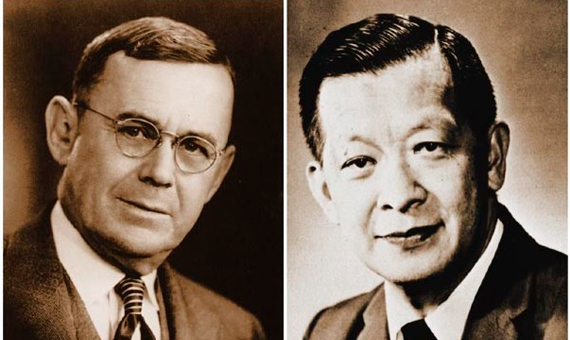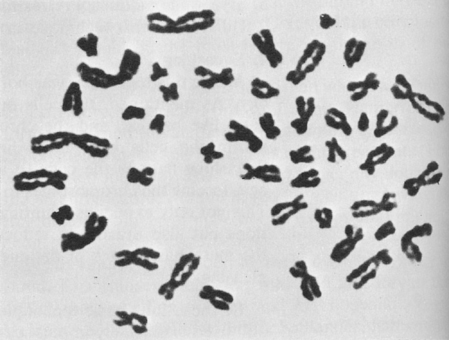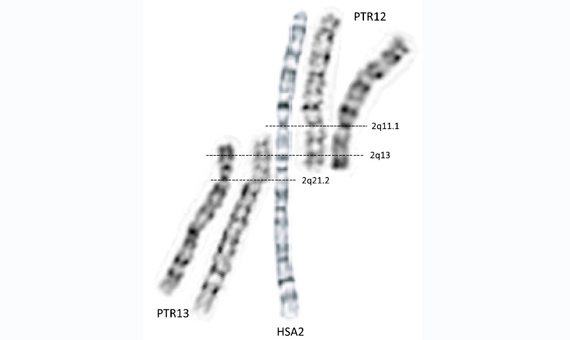Some 60 years ago, two researchers, Joe Hin Tjio and Albert Levan, discovered that the number of chromosomes (karyotype) in humans was 46 chromosomes, that is, 23 pairs and not 48 as was thought previously (1). The key to this discovery was the introduction of a series of improvements in culture techniques applied to human fibroblasts, especially as regards treatment with colchicine, which interrupts cell division at an appropriate stage for chromosome observation. This is known as the metaphase, during which chromosomes are contracted so they can be properly seen through a microscope. Interestingly, these same improvements were used over the following years to determine that our closest ancestors (large apes, such as chimpanzees, bonobos, gorillas or orangutans) possessed 48 chromosomes. How and when did this change in the number of chromosomes take place? Above all, what role did this difference play in the origin of our species? The latest breakthroughs in genetic analysis techniques are making great progress in solving these two questions.

Chromosome fusion: the reason for the difference
At the start of the 1960s, cytogenetic techniques were still not prepared for comparative studies of chromosomes in general and in primates, specifically. The techniques that were honed at a later date to obtain colored band and interband patterns in chromosomes revealed that our second largest chromosome is the result of a fusion of two chromosomes belonging to our closest evolutionary ancestors.

However, it was not until after the 1970s that molecular techniques allowing direct analysis of DNA on chromosomes arrived, before which in-depth characterization of the chromosome rearrangement that distinguishes us from the large apes was not possible. Thus, it was seen that more or less in the center of our chromosome 2 there were telomeric and subtelomeric DNA sequences (normally present at only one end of chromosomes, but not in internal areas) (2). This made it clear that the fusion of the two chromosomes had been complete, that is, from one end to the other. Nowadays, the availability of human genome and the genome of large apes has revealed how the genetic content of our chromosome 2 corresponds to the sum of the two chromosomes of our ape ancestors.

However, it has also been found that the fusion area that originated our chromosome 2 lacks some regions and sequences that correspond to subtelomeric areas present in the two chromosomes fused in our species. In other words, the fusion must have involved loss and rearrangement of part of the genetic material of the two originally separate chromosomes in the ancestors we have in common with the large apes.
Denisovans, Neanderthals and large apes: when did we separate?
Analyses being performed currently on genomes of extinct species that are directly related to us, such as Denisovans and Neanderthals, reveal that these species already presented the chromosome fusion that originated the long chromosome 2 that is characteristic of humans (3). Therefore, this rearrangement of chromosomes goes a long way back in time: estimates using various methods date this from 0.75 to 4.5 million years ago.
The fact that Denisovans and Neanderthals had the same chromosome number as we do may explain why the descendants from inter-species cross-breeding with our species were viable and possibly fertile. This would also explain why traces of their genetic characteristics remain in our genome, as shown by the comparative genomic analysis of the three species. However, the hypothetical descendants of breeding between the three hominid species mentioned (46 chromosomes) and their large ape ancestors (48 chromosomes) would have had problems of chromosome incompatibility and would probably not have been viable. In fact, no traces of specific genetic characteristics of the large apes have been found in our genome. Therefore, the chromosome fusion may have acted as an efficient mechanism for reproductive isolation that isolated us from the ancestors of the large apes.
Lastly, there is a possibility that the chromosome fusion that originated our chromosome 2 may have been associated with the appearance of our distinctive characteristics. Thus, several genes in our chromosome 2 that are found near the area of chromosome fusion are expressed more intensely in our species than in that of large apes. These genes are expressed, above all, in highly significant tissues and organs, such as the brain and the gonads (4). Secondly, the loss of certain DNA sequences that took place as the result of the fusion may have had “positive” effects on our ancestors.
To finally clarify what occurred in the chromosome rearrangement that is so characteristic of our species, in coming years we will have to attempt to obtain the DNA of extinct species that are older than Homo Erectus or Homo Heidelbergensis, thereby determining whether the fusion is associated with all “human” lineages; or performing an in-depth comparative analysis of the fusion area of our chromosome 2 and the subtelomeric areas of the two large ape chromosomes involved in the fusion, which has not yet been possible.
Manuel Ruiz Rejón
Granada University, Autonomous University of Madrid
References:
- J. Tjio and A. Levan. 1956. The chromosome number of Man. Hereditas, 42( 1-2): 1-6.
- W. Ijdo et al.1991. Origin of human chromosome 2: an ancestral telomere-telomere fusión. PNAS, 88: 9051-9056.
- Meyer et al. 2012 A high-coverage genome sequence from an archaic Denisovan individual. Science, 338:222-226.; K. H. Miga. 2016. Chromosome-specific Centromere sequences provide an estímate of the Ancestral Chromosome 2 Fusion event in Hominin Genome.Journ. of Heredity. 1-8. Doi:10.1093/jhered/esw039.
- GTEx Portal, http://www.gtexportal.org/home.
Comments on this publication